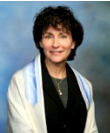Below is the complete text version.
Pesach 5773: What a Feeling by Rabbi Debra Nesselson
Passover is all about feeling, feeling that comes from remembering. How we feel is sometimes all that really matters.Maya Angelou, the poet, states it simply but profoundly: "I’ve learned that people will forget what you said, people will forget what you did, but people will never forget how you made them feel."
That’s what Passover is for the Jewish people. We are instructed to do more than merely tell the story around our Seder tables—it’s a start, but it’s not enough. We have to place ourselves back in time; we have to place ourselves into the story, and with the blessing of empathy, try to imagine what it must have felt like. We are asked to imagine slavery, imagine our despair, imagine the brutality, imagine our wretched conditions, and for many of us, that’s not such an easy undertaking.
The movie, Lincoln, demonstrates the point. The film was fascinating for its depiction of the complex and strong-armed political machinations involved in passage of the 13th Amendment to the U.S. Constitution. It was a start in freeing America’s slaves, (yet again slavery), a good start. Though fascinating, it wasn’t the historical narrative which was so striking. Rather, it was the multitude of images we were left with. It was the visual narrative giving us a view of the suffering of the soldiers; the vivid, gory brutality of war’s bloody casualties; the loneliness of being Lincoln and the utter darkness of the White House. It was the visual depiction which enabled many of us to place ourselves back in time, and without which many of us would go on thinking about the Civil War in much the way it is described in our history textbooks. Sometimes seeing is believing and sometimes seeing is feeling. And, if it is difficult to imagine life some 150 years ago, all the moreso is the challenge we face every year during Passover, in trying to place ourselves back in time into a narrative which our tradition says took place over 3000 years ago!
When we think about slavery, about the dehumanization of human beings, unfortunately we do not need to venture back so far in time. We live in a world in which genocides have taken place during our own lifetimes. Yet, as much as we learn about the Rwanda’s, the Darfur’s and the Holocaust, it’s difficult to even imagine placing ourselves into those horrific abysses. Perhaps for surviving victims of the Holocaust it is far more accessible, as the visual images return in flashback after flashback.
When I visit the U.S. Holocaust Memorial Museum, it’s never the facts, nor the reports, communications or the records which sear the memory of the Holocaust into my heart and soul, but rather it is in that mound of shoes, or in the visuals created by Nellie Sachs’ poem, O The Chimney’s, or in the lyrical prose of Elie Wiesel—that’s where our hearts are stirred as well as our minds—this is the place where the deepest memories are created of episodes we are unable to directly bear witness to.
Passover is really such a challenge. How can we know a world which has vanished? The photos of Roman Vishniac depict the life of Polish Jewry before the Nazis destroyed that civilization— an entire civilization—and when those few who somehow survived are gone, we must ask as the author Paul Celan does, "Who will bear witness for the witness?" Our children and grandchildren know only a world with the nation of Israel in it. It’s all I’ve ever known. But I remember well feeling my parents’ deep consternation during the Six Day War, I remember feeling the joy beaming in Israelis’ eyes during the pioneering years (those funny kibbutznik hats), and we feel the ominous threat of an Iran which has vowed to destroy our Jewish homeland.
Paradoxically, now we also battle a lack of feeling, an apathy among many of our youth for all things Jewish, even as they question Israel’s motives but give credence to an Arab press which espouses that Zionsim is racism. This too, is part of the Pesach story. Placing ourselves into the story is pivotal to who we are as a people. Remembering who we are as a people borne of an historical consciousness which enables us to feel, transcends mere historiography; that’s the stuff of the facts and figures we find in history textbooks.
And, then there’s the Jewish version of history; it flows from a feeling derived from faith and hope in a Redeemer who somehow ultimately brings coherence to this crazy world. How do we feel the essence of the life of our people? This is the ponderous and awesome responsibility we must assume as Jewish adults because if not us, who will bear witness for the witness?
What does it mean to be a Jew? Well, it starts with a feeling. It’s a way of being in the world, a way of stepping up and mattering, of making a difference to our people and to the world. God gave us memory so that we might have roses in December. And God gave us the ability to feel and the blessing of memory so that we might experience our story again and again each year around our Seder tables.
That’s what Passover is for the Jewish people. We are instructed to do more than merely tell the story around our Seder tables—it’s a start, but it’s not enough. We have to place ourselves back in time; we have to place ourselves into the story, and with the blessing of empathy, try to imagine what it must have felt like. We are asked to imagine slavery, imagine our despair, imagine the brutality, imagine our wretched conditions, and for many of us, that’s not such an easy undertaking.
The movie, Lincoln, demonstrates the point. The film was fascinating for its depiction of the complex and strong-armed political machinations involved in passage of the 13th Amendment to the U.S. Constitution. It was a start in freeing America’s slaves, (yet again slavery), a good start. Though fascinating, it wasn’t the historical narrative which was so striking. Rather, it was the multitude of images we were left with. It was the visual narrative giving us a view of the suffering of the soldiers; the vivid, gory brutality of war’s bloody casualties; the loneliness of being Lincoln and the utter darkness of the White House. It was the visual depiction which enabled many of us to place ourselves back in time, and without which many of us would go on thinking about the Civil War in much the way it is described in our history textbooks. Sometimes seeing is believing and sometimes seeing is feeling. And, if it is difficult to imagine life some 150 years ago, all the moreso is the challenge we face every year during Passover, in trying to place ourselves back in time into a narrative which our tradition says took place over 3000 years ago!
When we think about slavery, about the dehumanization of human beings, unfortunately we do not need to venture back so far in time. We live in a world in which genocides have taken place during our own lifetimes. Yet, as much as we learn about the Rwanda’s, the Darfur’s and the Holocaust, it’s difficult to even imagine placing ourselves into those horrific abysses. Perhaps for surviving victims of the Holocaust it is far more accessible, as the visual images return in flashback after flashback.
When I visit the U.S. Holocaust Memorial Museum, it’s never the facts, nor the reports, communications or the records which sear the memory of the Holocaust into my heart and soul, but rather it is in that mound of shoes, or in the visuals created by Nellie Sachs’ poem, O The Chimney’s, or in the lyrical prose of Elie Wiesel—that’s where our hearts are stirred as well as our minds—this is the place where the deepest memories are created of episodes we are unable to directly bear witness to.
Passover is really such a challenge. How can we know a world which has vanished? The photos of Roman Vishniac depict the life of Polish Jewry before the Nazis destroyed that civilization— an entire civilization—and when those few who somehow survived are gone, we must ask as the author Paul Celan does, "Who will bear witness for the witness?" Our children and grandchildren know only a world with the nation of Israel in it. It’s all I’ve ever known. But I remember well feeling my parents’ deep consternation during the Six Day War, I remember feeling the joy beaming in Israelis’ eyes during the pioneering years (those funny kibbutznik hats), and we feel the ominous threat of an Iran which has vowed to destroy our Jewish homeland.
Paradoxically, now we also battle a lack of feeling, an apathy among many of our youth for all things Jewish, even as they question Israel’s motives but give credence to an Arab press which espouses that Zionsim is racism. This too, is part of the Pesach story. Placing ourselves into the story is pivotal to who we are as a people. Remembering who we are as a people borne of an historical consciousness which enables us to feel, transcends mere historiography; that’s the stuff of the facts and figures we find in history textbooks.
And, then there’s the Jewish version of history; it flows from a feeling derived from faith and hope in a Redeemer who somehow ultimately brings coherence to this crazy world. How do we feel the essence of the life of our people? This is the ponderous and awesome responsibility we must assume as Jewish adults because if not us, who will bear witness for the witness?
What does it mean to be a Jew? Well, it starts with a feeling. It’s a way of being in the world, a way of stepping up and mattering, of making a difference to our people and to the world. God gave us memory so that we might have roses in December. And God gave us the ability to feel and the blessing of memory so that we might experience our story again and again each year around our Seder tables.
Your comments are welcome.

